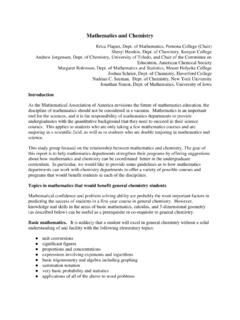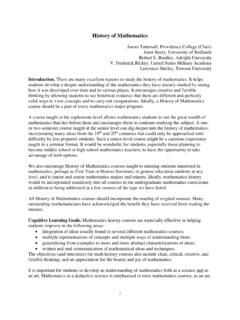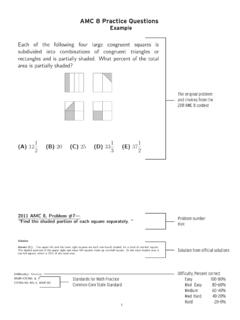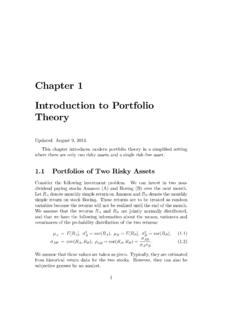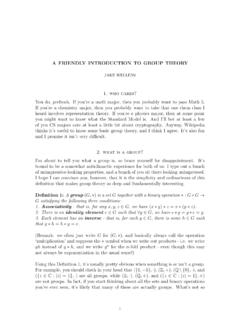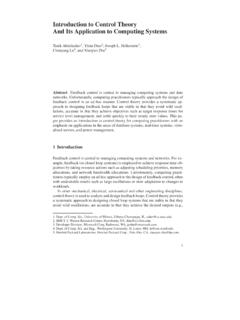Transcription of An Introduction to Elementary Set Theory
1 An Introduction to Elementary Set TheoryGuram Bezhanishvili and Eachan Landreth 1 IntroductionIn this project we will learn Elementary set Theory from the original historical sources by two keyfigures in the development of set Theory , Georg Cantor (1845 1918) and Richard Dedekind (1831 1916). We will learn the basic properties of sets, how to define the size of a set, and how to comparedifferent sizes of sets. This will enable us to give precise definitions of finite and infinite sets. Wewill conclude the project by exploring a rather unusual world of infinite Cantor, the founder of set Theory , considered by many as one of the most original mindsin the history of mathematics, was born in St. Petersburg, Russia in 1845. His parents moved thefamily to Frankfurt, Germany in 1856. Cantor entered the Wiesbaden Gymnasium at the age of15, and two years later began his university career in Z urich, Switzerland.
2 In 1863 he moved tothe University of Berlin, which during Cantor s time was considered the world s leading center ofmathematical research. Four years later Cantor received his doctorate under the supervision ofthe great Karl Weierstrass (1815 1897). In 1869 Cantor obtained an unpaid lecturing post at theUniversity of Halle. Ten years later he was promoted to a full professor. However, Cantor neverachieved his dream of holding a Chair of Mathematics at Berlin. It is believed that one of the mainreasons was the nonacceptance of his theories of infinite sets by the leading mathematicians of thattime, most noticeably by Leopold Kronecker (1823 1891), a professor at the University of Berlinand a very influential figure in German mathematics, both mathematically and married in 1874 and had two sons and four daughters. Ten years later Cantor sufferedthe first of several mental breakdowns that were to plague him for the rest of his life.
3 Cantor died in1918 in a mental hospital at Halle. By that time his revolutionary ideas were becoming accepted bysome of the leading figures of the new century. One of the greatest mathematicians of the twentiethcentury, David Hilbert (1862 1943), described Cantor s new mathematics as the most astonishingproduct of mathematical thought [17, p. 359], and claimed that no one shall ever expel us fromthe paradise which Cantor has created for us [17, p. 353]. More on Georg Cantor can be found in[8, 11, 12, 15, 17, 19] and in the literature cited Dedekind was an important German mathematician, who was also a friend to, and anally of, Cantor. He was born in Braunschweig, Germany in 1831. In 1848 Dedekind entered theCollegium Carolinum in Braunschweig, and in 1850 he entered the University of G ottingen animportant German center of mathematics and the home of the great Carl Friedrich Gauss (1777 1855).
4 Dedekind became the last student of Gauss. In 1852 Dedekind received his doctorate, andspent the next two years at the University of Berlin the mecca of mathematics of the second halfof the nineteenth century. At the University of Berlin, Dedekind became friends with BernhardRiemann (1826 1866). They both were awarded the Habilitation in 1854, upon which Dedekind Department of Mathematical Sciences;New Mexico State University;Las Cruces,NM to G ottingen to teach as G ottingen, Dedekind became friends withLejeune Dirichlet (1805 1859). After Dirichlet s death, Dedekind edited Dirichlet s lectures onnumber Theory , which were published in 1863. He also edited the works of Gauss and 1858 to 1862 Dedekind taught at the Polytechnic Institute in Z urich. In 1862 his alma materthe Collegium Carolinum was upgraded to a Technische Hochschule (Institute of Technology), andDedekind returned to his native Braunschweig to teach at the Institute.
5 He spent the rest of hislife there. Dedekind retired in 1894, but continued active mathematical research until his is mostly known for his research in algebra and set Theory . He was the first to definereal numbers by means of cuts of rational numbers. To this day many schools around the globeteach the Theory of real numbers based on Dedekind s cuts. Dedekind was the first to introducethe concept of an ideal a key concept in modern algebra generalizing the ideal numbers of ErnstKummer (1810 1893). His contributions to set Theory as well as to the study of natural numbersand modular lattices are equally important. In fact, his 1900 paper on modular lattices is consideredthe first publication in a relatively new branch of mathematics called lattice Theory . Dedekind wasa well-respected mathematician during his lifetime. He was elected to the Academies of Berlin andRome as well as to the French Academy of Sciences, and also received honorary doctorates fromthe universities of Oslo, Z urich, and Braunschweig.
6 More on Richard Dedekind can be found in[15, 17, 22, 24] and in the literature cited beginning of Dedekind s friendship with Cantor dates back to 1874, when they first meteach other while on holidays at Interlaken, Switzerland. Their friendship and mutual respect lasteduntil the end of their lives. Dedekind was one of the first who recognized the importance of Cantor sideas, and became his important ally in promoting set is only fitting to study set Theory from the writings of Cantor and Dedekind. In this projectwe will be working with the original historical source by Cantor Beitr age zur Begr undung dertransfiniten Mengenlehre ( Contributions to the founding of the Theory of transfinite numbers. I )[5] which appeared in 1895, and the original historical source by Dedekind Was sind und wassollen die Zahlen?
7 ( The nature and meaning of numbers ) [9] which appeared in 1888. AnEnglish translation of Cantor s source is available in [6], and an English translation of Dedekind ssource is available in [10].2 SetsIn the first half of the project our main subject of study will besets. This is how Cantor defined aset: By an aggregate we are to understand any collection into a wholeMof definite and separateobjectsmof our intuition or our thought. These objects are called the elements ofM. [6, p. 85] The German word for a set isMenge, which is the reason Cantor denotes a set byMand itselements bym. In [6] Menge is translated as an aggregate, but it has since become common to usethe word set Germany, as well as in some other European and Asian countries, Habilitation is the highest academic qual-ification a scholar can achieve.
8 It is earned after obtaining a , and requires the candidate to write a secondthesis, known as a Habilitation thesis. The level of a Habilitation thesis has to be considerably higher than thatof a thesis, and must be accomplished independently. The Habilitation qualifies the holder to independentlysupervise doctoral candidates. In Germany such a post is known as Privatdozent. After serving as a Privatdozent,one is eligible for full professorship [16].2 Examples of sets are to be found everywhere around us. For example, we can speak of the setof all living human beings, the set of all cities in the US, the set of all sentences of some language,the set of all prime numbers, and so on. Each living human being is an element of the set of allliving human beings. Similarly, each prime number is an element of the set of all prime numbers,and so a set andsis an element ofS, then we writes S.
9 If it so happens thatsis not anelement ofS, then we writes / S. IfSis the set whose elements ares,t, andu, then we writeS={s,t,u}. The left brace and right brace visually indicate the bounds of the set, while whatis written within the bounds indicates the elements of the set. For example, ifS={1,2,3}, then2 S, but 4/ are determined by their elements. The order in which the elements of a given set are listeddoes not matter. For example,{1,2,3}and{3,1,2}are the same set. It also does not matterwhether some elements of a given set are listed more than once. For instance,{1,2,2,2,3,3}is stillthe set{1,2,3}.Many sets are given a shorthand notation in mathematics because they are used so few Elementary examples are the set of natural numbers,{0,1,2,..},denoted by the symbolN, the set of integers,{.., 2, 1,0,1,2,..},denoted by the symbolZ, the set of rational numbers, denoted by the symbolQ, and the set ofreal numbers, denoted by the set may be defined by a property.
10 For instance, the set of all planets in the solar system, theset of all even integers, the set of all polynomials with real coefficients, and so on. For a propertyPand an elementsof a setS, we writeP(s) to indicate thatshas the propertyP. Then the notationA={s S:P(s)}indicates that the setAconsists of all elementssofShaving the colon : is commonly read as such that, and is also written as |. So{s S|P(s)}is analternative notation for{s S:P(s)}. For a concrete example, considerA={x R:x2= 1}.Here the propertyPis x2= 1. Thus,Ais the set of all real numbers whose square is the following sentences, identify the property, and translate the sentence to The set of all even The set of all odd prime The set of all cities with population more than one million an alternative description of the sets specified {x R:x2= 1}.2.{x Z:x > 2 andx 3}.
